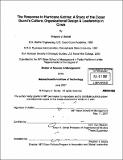| dc.contributor.advisor | John van Maanen. | en_US |
| dc.contributor.author | Sanial, Gregory J | en_US |
| dc.contributor.other | Sloan School of Management. | en_US |
| dc.date.accessioned | 2007-11-16T14:15:37Z | |
| dc.date.available | 2007-11-16T14:15:37Z | |
| dc.date.issued | 2007 | en_US |
| dc.identifier.uri | http://hdl.handle.net/1721.1/39510 | |
| dc.description | Thesis (S.M.)--Massachusetts Institute of Technology, Sloan School of Management, 2007. | en_US |
| dc.description | "June 2007." | en_US |
| dc.description | Includes bibliographical references (p. 109-111). | en_US |
| dc.description.abstract | Hurricane Katrina slammed into the United States Gulf Coast early on August 28, 2005 killing almost 2,000 people and causing $81 billion in damages making Katrina the costliest natural disaster in United States history. The sheer magnitude of the devastation and destruction in New Orleans and the surrounding area remains incomprehensible to many disaster planners. The subsequent response to the destruction and needs of those caught in the storm's wake resulted in widespread criticism of local, state, and federal organizations and governments. One agency that received widespread praise for its response to Katrina was the United States Coast Guard. The Coast Guard rescued well over 30,000 people immediately following the storm and, later, after much criticism forced the head of the federal government's response effort to resign, President Bush placed a Coast Guard Vice Admiral in charge of the response efforts. Why was the Coast Guard so successful in its response to Hurricane Katrina when virtually every other organization failed? Why did the President turn to a Coast Guard Vice Admiral to coordinate the federal government's response when others had failed? | en_US |
| dc.description.abstract | (cont.) This thesis examines the Coast Guard's Culture, Organizational Design, and Leadership Model in an effort to understand the ability, strengths and weaknesses of the service to respond to crises such as catastrophic disasters like Katrina. The research was conducted through a survey of available literature, interviews with Coast Guard members who responded to Katrina in a variety of capacities and at various levels in the organization, and personal experience and observation. The thesis concludes with a discussion of the implications for the future of the Coast Guard in both crisis response and everyday operations. | en_US |
| dc.description.statementofresponsibility | by Gregory J. Sanial. | en_US |
| dc.format.extent | 111 p. | en_US |
| dc.language.iso | eng | en_US |
| dc.publisher | Massachusetts Institute of Technology | en_US |
| dc.rights | M.I.T. theses are protected by copyright. They may be viewed from this source for any purpose, but reproduction or distribution in any format is prohibited without written permission. See provided URL for inquiries about permission. | en_US |
| dc.rights.uri | http://dspace.mit.edu/handle/1721.1/7582 | |
| dc.subject | Sloan School of Management. | en_US |
| dc.title | The response to Hurricane Katrina : a study of the Coast Guard's culture, organizational design & leadership in crisis | en_US |
| dc.type | Thesis | en_US |
| dc.description.degree | S.M. | en_US |
| dc.contributor.department | Sloan School of Management | |
| dc.identifier.oclc | 173844717 | en_US |
